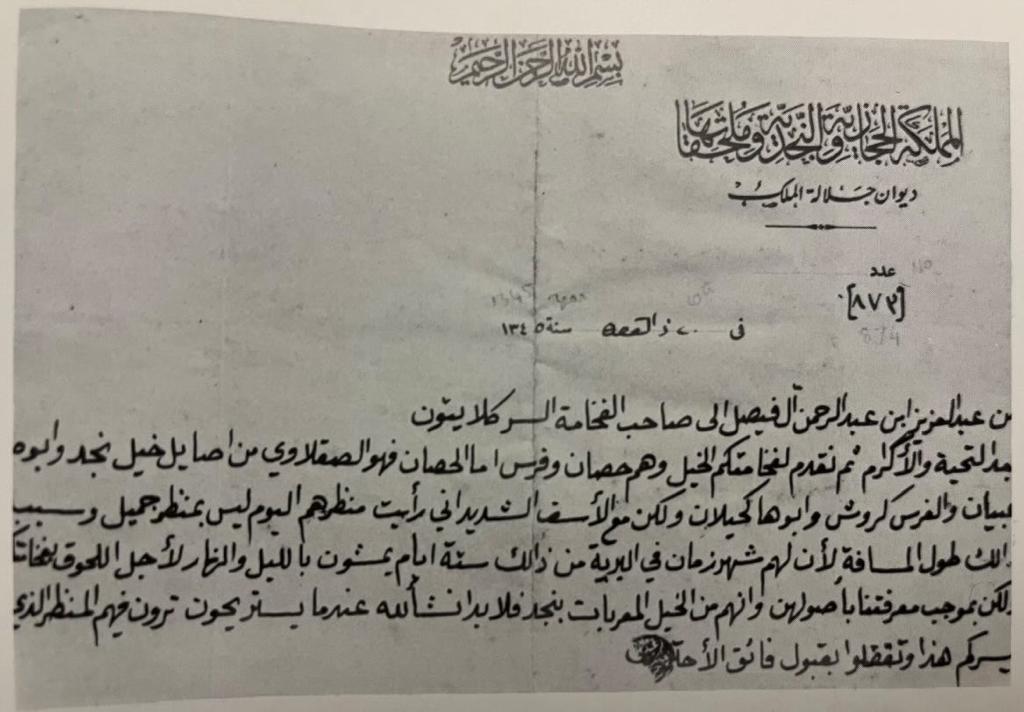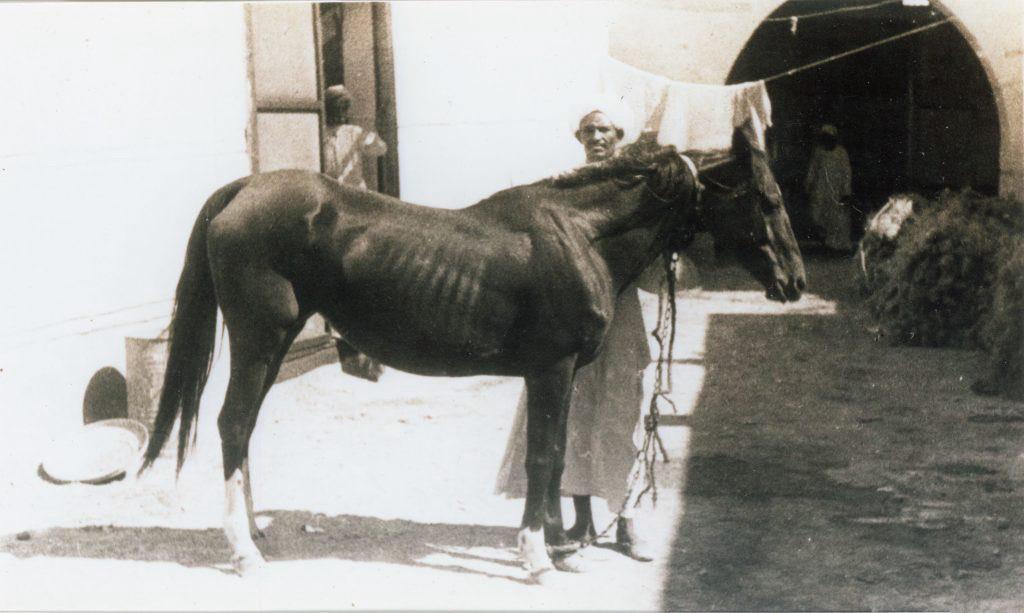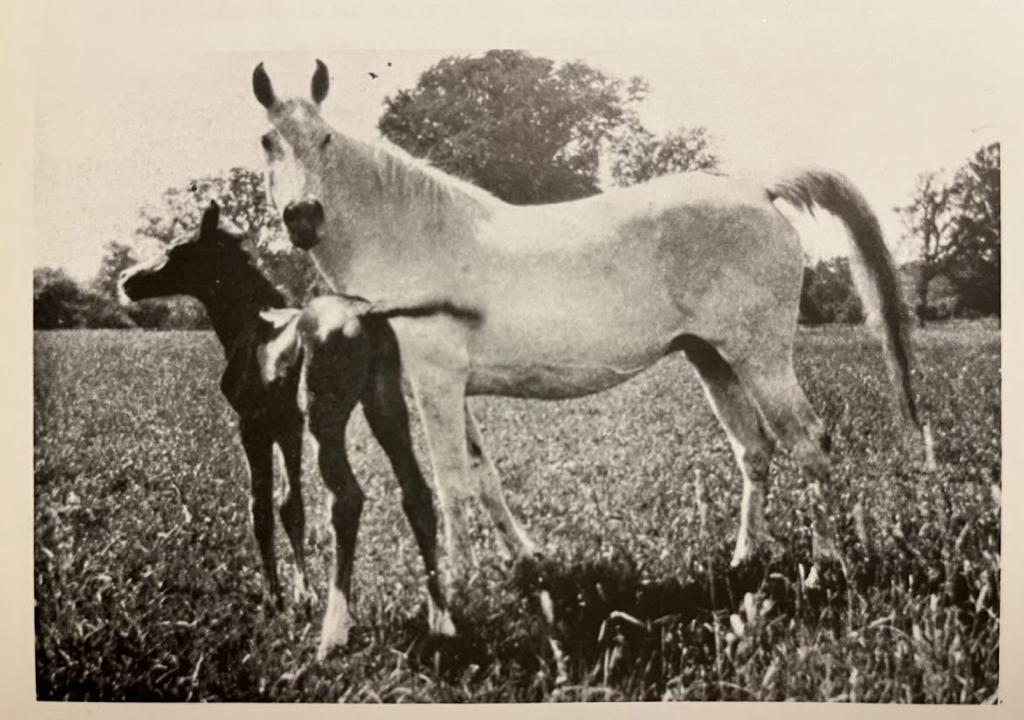Hujjah of Krush mare and Saqlawi stallion in the words of King Abd al-‘Aziz Aal Saud from 1927
An image of this document appears on page 79 of Peter Upton’s The Arab Horse (The Crowood Press, 1989). It is inconspicuously labeled as “Fig. 132. Facsimile of an Arab letter to Sir Gilbert Clayton“.

Here is my translation, based off the image above, with my comments between the brackets:
In the name of God, the Merciful the Compassionate [printed letterhead]
The Hijazi and Najdi Kingdom and its dependencies [printed letterhead]
The Diwan of His Majesty the King [printed letterhead]Number 873
20 Dhul Qi’dah Year 1345 [printed year, date equivalent to Saturday May 21, 1927]From Abd al-‘Aziz son of ‘Abd al-Rahman of the House of Faysal [i.e., Faysal ibn Turki] to his Excellency the Sir Clayton:
After greetings and compliments, we present Your Excellency with the horses, a male horse and a mare. As to the male horse, he is the Saqlawi of the most authentic [asaayil, plural of asil] horses of Najd; his sire is an ‘Ubayyan; the mare is Krush; her sire is a Kuhaylan.
However, quite regrettably I saw today that their looks were not nice looks; the reason for this is the length of the journey, because they’ve been in the wilderness [al-barriyah, literally, “the bush”] for a monthlong period; from there on, six days of walking night and day to catch up with your Excellency.However, in light of our knowledge of their origins [usul, plural of asl], and their being of the mu’arrabat horses in Najd, there is no doubt that, once they are rested God willing, you will see in them the looks that will please you. With this, please accept my utmost respect [seal of King ‘Abd al-‘Aziz]
We are looking at a most precious document, an Arabian horse hujjah in the own words of King ‘Abd al-‘Aziz. It is the only such one that I know of. But which horses does it reference?

Upton provided a relatively accurate translation on pages 78 and 79 of his book but stated that it pertained to the mare Faras (photo above) and the stallion Kasim. However, King ‘Abd al-‘Aziz gifted Faras and Kasim to King George VI of Great Britain in 1937, a full ten years after the date on the document. The date of 20 Dhul Qi’dah 1345 of the Muslim calendar corresponds to the date of May 21, 1927, of the Christian calendar.
Even in the very unlikely assumption that the date on the document was a mistake, the letterhead on the document refers to the Kingdom of Hijaz and Najd. By 1937 this was no longer the official name of the kingdom. Its name has been the Kingdom of Saudi Arabia since September 1932. The “Kingdom of Hijaz and Najd” was the official name the country adopted at the Treaty of Jeddah of May 20, 1927 (one day before the date on the document!) between the same Sir Gilbert Clayton and Prince Faysal, son of King ‘Abd al-‘Aziz. Second, while Faras was indeed a Krush, Kasim was an Ubayyan, not a Saqlawi. In sum, Upton is wrong in attributing the hujjah to Faras and Kasim.
A strong possibility is that the hujjah pertains to the mare Dafina (photo below, also from Upton’s book), a Krush mare King ‘Abd al-‘Aziz gifted to Lady Wentworth in 1927 through the good offices of Sir Clayton, in return for the hospitality Lady Wentworth had extended Prince Faysal during his visit to the United Kingdom.

Note that Upton’s translation of the document has an additional line not visible in the document’s image above. It reads: “NB. Her sire is Kehilan, i.e., Kehilan of the same Kehilan el Krush strain“. The sire of Faras is recorded as an ‘Ubayyan. The Saqlawi horse in the document remains unidentified.
The presence of Sir Gilbert Clayton in the Hijazi port of Jeddah for the signing of the treaty of same name the day before the date on the hujjah provides excellent context for the document, per my translation:
King ‘Abd al-‘Aziz indicated that he saw the horses on the same day as the date on the document [al-yawm, “today”, so May 21, 1927]. The King was not in Jeddah the day before for the signing of the treaty with Sir Clayton; it was his son Prince Faysal who signed it on his behalf. The letter is addressed from the Diwan/Office of the King, which is in the capital Riyadh. All this makes it possible to presume that the King was in Riyadh or its vicinity on that day.
The King also wrote that it would take six uninterrupted days for the horses to reach Sir Clayton. That’s exactly the distance between Riyadh and Jeddah on horseback. Per Google Maps, it’s an 11 day walk on foot at the average human walking speed of 2 miles per hour. Ridden horses walk twice as fast, at 4 miles per hour on average, which would make it possible to cross that distance in five and a half days to six days.
In summary, it looks like Sir Clayton was in Jeddah for the signing of the treaty on March 20, 1927, and that the King took the opportunity of his presence there to send the mare and the horse with him from Riyadh. Despite seeing the horses’ poor condition after a month in the desert wilderness [al-barriyah, literally “the bush”], the King appears to have decided to send them on to Jeddah before the departure of Sir Clayton from that city. The horses would have reached Jeddah by March 28, after a nonstop ride, to embark with Sir Clayton.
One last point: I am intrigued by the use of the term mu’arrabat. I will need to look deeper into its exact meaning.
It does seem plausible that the Krush mare is Dafina. Another point in favour of the hujjah referring to her, rather than Faras and Kasim, is that Sir Gilbert died in 1929.
Same year, same strain, same provenance, same intermediary as Dafina
Can anyone who has the early British studbooks check them for a desert-bred Saqlawi stallion imported to the UK at around the same time as Dafina? Unless that Saqlawi stallion’s final destination was not the UK.
Kate may be able to access the 1930 Vol 26 edition of the General Stud Book, as I think it is public domain in her country – https://books.google.com/books/about/The_General_Stud_Book.html?id=ZahOAAAAYAAJ
Some of us have photocopies of the GSB Arabian section but for future reference it’s not going to help in this time period, since the last Arabian added was Dwarka in Vol 25, which was published before 1927.
I’ve just reviewed the UK Arabian Stud Book through Vol 6, published 1944, and I’m not seeing a candidate to be the horse described here.
Lady Wentworth bred from Dafina without registering her; she does not appear in the stud book until Vol 5 (1937) in the ownership of Mrs Nina Elms. Her studbook status is confusing, since Vol 5 has her foaled in 1926 and does not give an importation date, while her daughter Dafinetta’s registration in Vol 6 in the Guinness ownership shows Dafinetta foaled in 1935, gives Dafina no foaling date, and says she was imported in 1925.
One more thought: It appears Dafina was a yearling in 1927; perhaps the colt was too, and if they were in such poor condition at the start, it may be that he didn’t survive the trip.
If you look carefully at the document, someone wrote the number 1345 in light pencil above the numerals for the year.
Here is what Upton’s The Arab Horse has on Dafina:
DAFINA
AHS Volume 5, page 123
Imported 1927
A Keheilet el Krush
A white mare foaled in 1921.
Bred in the Nejd by the Muteyr tribe.
Dam A Keheilet el Krush of King (sic) Faysal Ibn Saoud
Sire A Horse of King (sic) Faysal Ibn Saoud, a Keheilan el Krush (Krushan).
Imported through King Ibn Saoud, in June 1927, by Sir Gilbert Clayton, for Lady Wentworth.
Reserve Arab Brood Mares, NPS Show, 1936. She was sold to Mrs. Elm in 1936 and her last registered foal was born in 1947 (Dafina was 26 years old).